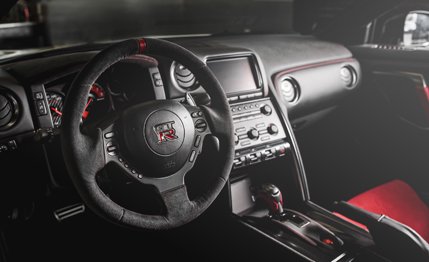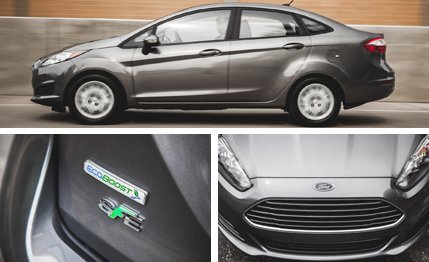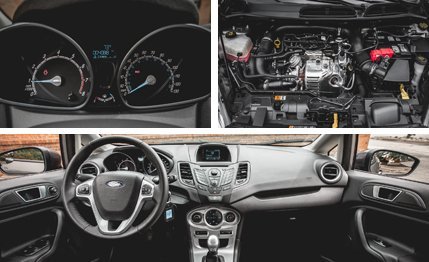
 Instrumented Test
Instrumented Test
Just $995 separates the 2014 Ford Fiesta 1.0L EcoBoost sedan from its standard four-cylinder–powered Fiesta SE counterpart. That amount covers the SE EcoBoost Fuel Economy package, which includes Ford’s teensy 1.0-liter turbocharged three-cylinder engine, a rear spoiler, and strangely cool 15-inch steel wheels with aero-minded hubcaps.
We’ve tested the $500-dearer 1.0L hatchback, but this is our first exam of the four-door. As with the hatch, the $17,240 1.0L EcoBoost sedan comes married to midlevel SE trim and a five-speed manual transmission—an automatic is not available.
These days, nearly $18K buys you the most entry-level version of the one-size-up (and 10Best-awarded) Mazda 3 sedan—as well as a base Focus sedan—so Ford’s “get” here is an EPA-estimated (and recently downgraded) 31 mpg city and 43 mpg highway. That is the same rating as the 1.0L five-door’s, and it betters the figures of a manual Fiesta sedan by 3 and 7 mpg. No other nonhybrid “real cars” save for the unloved Mitsubishi Mirage beat it. With our typically heavy right foot, we recorded a solid 30 mpg in mixed city/highway driving. That fell 2 mpg off the mark set by the five-door 1.0L but beat our most-recent recorded figure for the 1.6-liter Fiesta by 1 mpg.


Happily, the three-cylinder produces 3 more horsepower and a whopping 36 more lb-ft of torque than the standard Fiesta’s naturally aspirated 1.6-liter four, for totals of 123 and 148. Like the four, the three-cylinder produces its maximum power high in the rev range, so drivers will need to really work the five-speed to make haste. Our test car made it to 60 mph in 8.7 seconds, beating the Fiesta 1.6 sedan by 0.6 second.
Out on the mean streets, the engine’s power advantage fades at regular engine speeds—for instance, below 3000 rpm. The engine makes almost no usable torque at this point in the power band, so you’ll want to keep it in a lower gear. What’s more, wringing out the little engine is huge fun, thanks to its solid high-rpm thrust and offbeat three-cylinder thrum.
As with other Fiestas, the chassis boasts excellent damping and bump suppression, but the electric power steering isn’t particularly quick or talkative. (For maximum Fiesta spice, we suggest checking out the hot-hatch ST model.) The EcoBoost’s skinny 185-series Hankook Optimo tires give up grip well before the suspension runs out of steam but still enabled a respectable 0.84 g on the skidpad and contributed to a Honda Fit–beating 173-foot stop from 70 mph. The trade-off is a quiet ride, and indeed, at 70 mph we recorded a hushed 69 decibels in the Fiesta’s cabin. That’s 1 decibel quieter than a 2013 Lexus LS600hL we evaluated last year.


Our test car’s interior was fairly spartan, and unfortunately the vigorous checking of option-sheet boxes won’t change that much. The lone significant option is the $290 Comfort package (heated front seats and door mirrors, plus automatic climate control), which our test car included. Buyers must make do with the SE’s standard-equipment list (which includes cloth seats, Sync voice control for the audio and Bluetooth setups, and cruise control) but be willing to skip the SE’s optional MyFord Touch touch-screen infotainment system with navigation.
Is the EcoBoost 1.0L $995 better than the Fiesta’s 1.6? We think so, but Ford is aiming at a relatively small target here, especially by omitting an optional automatic transmission and pricing the car close to larger competitors. But buyers keen on the Fiesta’s small footprint and high EPA fuel-economy numbers—real-world efficiency be damned—won’t be disappointed, and neither will fans of oddball powertrains.